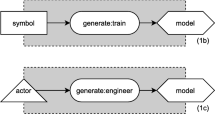Abstract
Adaptive predictive search (APS), is a learning system frame-work, which given little initial domain knowledge, increases its decision-making abilities in complex problems domains. In this paper we give an entirely domain-independent version of APS that we are implementing in the PEIRCE conceptual graphs workbench. By using conceptual graphs as the “base language” a learning system is capable of refining its own pattern language for evaluating states in the given domain that it finds itself in. In addition to generalizing APS to be domain-independent and CG-based we describe fundamental principles for the development of AI systems based on the structured pattern approach of APS. It is hoped that this effort will lead the way to a more principled, and well-founded approach to the problems of mechanizing machine intelligence.
The APS framework has been applied to a number of complex problem domains (including chess, Othello, pente and image alignment) where the combinatorics of the state space is large and the learning process only receives reinforcement at the end of each search. The unique features of the APS framework are its pattern-weight representation of control knowledge and its integration of several learning techniques including temporal difference learning, simulated annealing, and genetic algorithms. Morph, an APS chess sytem, is now being translated into PEIRCE.
Preview
Unable to display preview. Download preview PDF.
Similar content being viewed by others
References
J.L. Aronson. Truth and semantic networks. In Fourth Annual Workshop on Conceptual Structures, pages 161–171, 1989.
H.W. Davis and S. Chenoweth. The mathematical modeling of heuristics. Annals of Mathematics and Artificial Intelligence, pages 191–228, 1992.
J. Gould and R. Levinson. Experience-based adaptive search. In Machine Learning: Multi-Strategy Approach, volume 4. Morgan Kauffman, 1992. To appear.
R. E. Korf. Learning to solve problems by searching for macro-operators. Pitman, 1985.
R. Levinson. Pattern associativity and the retrieval of semantic networks. Computers and Mathematics with Applications, 23(6–9):573–600, 1992. Part 2 of Special Issue on Semantic Networks in Artificial Intelligence, Fritz Lehmann, editor.
R. Levinson, B. Beach, R. Snyder, T. Dayan, and K. Sohn. Adaptive-predictive game-playing programs. Journal of Experimental and Theoretical AI, 1992. To appear. Also appears as Tech Report UCSC-CRL-90-12, University of California, Santa Cruz.
R. Levinson and G. Ellis. Multilevel hierarchical retrieval. Knowledge-Based Systems, 1992. To appear.
Robert Levinson. A pattern-weight formulation of search knowledge. Technical Report UCSC-CRL-91-15, University of California Santa Cruz, 1989. Revision to appear in Computational Intelligence.
R. S. Michalski. A theory and methodology of inductive learning. In R. S. Michalski, J. G. Carbonell, and T. M. Mitchell, editors, Machine learning: An Artificial Intelligence Approach. Tioga Press, 1983.
S. Minton. Constraint based generalization-learning game playing plans from single examples. In Proceedings of AAAI-84, pages 251–254. AAAI, 1984.
T. M. Mitchell, J. G. Carbonell, and R. S. Michalski, editors. Machine Learning: A Guide to Current Research. Kluwer Academic Publishers, 1986.
T. M. Mitchell, R. Keller, and S. Kedar-Cabelli. Explanation based generalization: A unifying view. In Machine Learning 1, pages 47–80. Kluwer Academic Publishers, Boston, 1986.
T Niblett and A. Shapiro. Automatic induction of classification rules for chess endgames. Technical Report MIP-R-129, Machine Intelligence Research Unit, University of Edinburgh, 1981.
S. Omohundro. Efficient algorithms with neural network behavior. Technical Report UIUCDCS-R-87-1331, University of Illinois, April 1987.
Barney Pell. A computer game-learning tournament. (In Preparation), 1991.
J. R. Quinlan. Induction on decision trees. Machine Learning, 1:81–106, 1986.
A. Ralescu and A. Fadlalla. The issue of semantic distance in knowledge representation with conceptual graphs. In Proceedings of Fifth Annual Workshop on Conceptual Structures, pages 141–142, 1990.
C. E. Shannon. Programming a computer for playing chess. Philosophical Magazine, 41(7):256–275, 1950. See also Levy, D.N.L. (ed) (1988), Computer Games I, Springer Verlag, New York, pp. 81–88.
J. F. Sowa. Conceptual Structures. Addison-Wesley, 1983.
R. S. Sutton. Learning to predict by the methods of temporal differences. Machine Learning, 3(1):9–44, August 1988.
S. Watanabe. Pattern Recognition:Human and Mechanical Wiley, New York, 1985.
Author information
Authors and Affiliations
Editor information
Rights and permissions
Copyright information
© 1993 Springer-Verlag Berlin Heidelberg
About this paper
Cite this paper
Levinson, R. (1993). Towards domain-independent machine intelligence. In: Mineau, G.W., Moulin, B., Sowa, J.F. (eds) Conceptual Graphs for Knowledge Representation. ICCS 1993. Lecture Notes in Computer Science, vol 699. Springer, Berlin, Heidelberg. https://doi.org/10.1007/3-540-56979-0_14
Download citation
DOI: https://doi.org/10.1007/3-540-56979-0_14
Published:
Publisher Name: Springer, Berlin, Heidelberg
Print ISBN: 978-3-540-56979-4
Online ISBN: 978-3-540-47848-5
eBook Packages: Springer Book Archive




